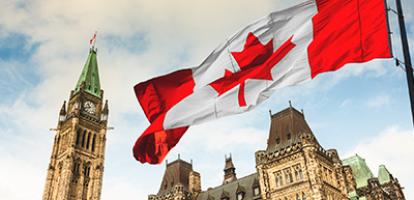The latest data (from February) indicate that the battle against inflation is almost over. Despite the encouraging inflation data, the Bank of Canada again held its policy rate at 5 percent on Wednesday. What gives? The bank, like many other central banks, was slow off the mark to raise rates as inflation took off. We worry it runs the risk of falling behind the curve again.
First, let’s examine why the bank might be hesitating to cut – the housing market and fiscal policy. Then, let’s examine why, in our view, that’s not enough.
Year-over-year headline inflation dropped inside the bank’s 1-3 percent range in January, and continued to fall in February, sitting at 2.8 percent. Core inflation, which strips out more volatile prices, also fell over those same two months, with the bank’s preferred measures – CPI-trim and CPI-median – sitting just above the range, at 3.2 percent and 3.1 percent, respectively.
While the downward trends are both positive, the bank’s target is 2 percent, so they suggest more to do.
First-quarter results for the Canadian housing market seem set to surprise on the upside. And this seems set to continue. Part of why households are ready to buy links back to why spending, in general, was so difficult to tame during the bank’s rate hikes over the last two years – namely, savings accumulated during the pandemic. Generous government transfers during extended lockdowns led to a savings overhang that people were able to draw on for much of the bank’s tightening campaign. Only now, with saving rates increasing, are there signs it is biting. A lowering of interest rates would reverse this effect.
On the fiscal side, many of our provincial governments (and we anticipate the federal government as well when it releases its budget next week) are set to continue spending in an inflationary fashion, where deficits are driven not by lower tax revenue but by higher expenditures. Lower interest rates that stimulate more demand elsewhere will only add fuel to the inflationary fire.
These are valid concerns – and others agree with the bank. But, we believe the following concerns are weightier.
First, looking at year-over-year measures is increasingly misleading. Headline inflation over the last three months has dropped well below target, to 1.3 percent (where we convert the three-month change into an annualized number to make comparable to the year-over-year numbers). The bank’s preferred measures of core inflation have been barely above target over the last three months: Trim inflation was 2.4 percent and Median inflation was 2.1 percent. Even food price inflation has slowed. While still above 2 percent year over year, over the last three months it was just 1.3 percent, and food prices have decreased slightly since last December.
The major exception has been shelter costs, which have increased at an annualized rate of 4.8 percent over the last three months. These costs have been driven by mortgage interest costs (which depend in a very direct way on the Bank of Canada’s policy rate). When mortgage interest costs are stripped out of the CPI, the index was lower in February 2024 than in July 2023, meaning that this measure of inflation has been negative over the last seven months.
Other macro indicators are suggestive of an economy running out of steam. The unemployment rate is up again, now at 6.1 percent – it was 5.1 percent last March. Business bankruptcies are on the rise and job vacancies continue to fall. And the bank’s Business Outlook Survey showed a normalization in business pricing behaviour – both in terms of frequency and magnitude of changes.
We think the latter considerations outweigh concerns over the housing market and our governments’ collective spending behaviour. As of now, it looks like the Canadian economy has achieved a proverbial “soft landing,” with inflation returning to target without a painful recession. However, the Bank of Canada’s real policy rate (its policy rate minus inflation) is now higher than at the beginning of the millennium (its nominal rate was 5.75 percent in January 2001 when inflation was 3 percent). Based on year-over-year inflation, the real rate is above 2 percent. Based on inflation over the last three months, it is above 3 percent, which is restrictive monetary policy by any measure.
If the bank waits too long and falls behind the curve, it will have to follow its expected June cut with several more in quick succession.
Jeremy Kronick is associate vice-president and director of the Centre on Financial and Monetary Policy at the C.D. Howe Institute, where Steve Ambler, a professor of economics at Université du Québec à Montréal, is the David Dodge Chair in Monetary Policy.
Published in the Globe and Mail





